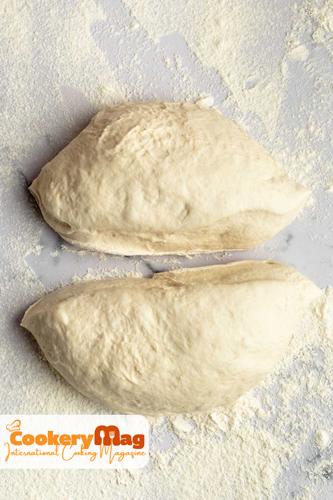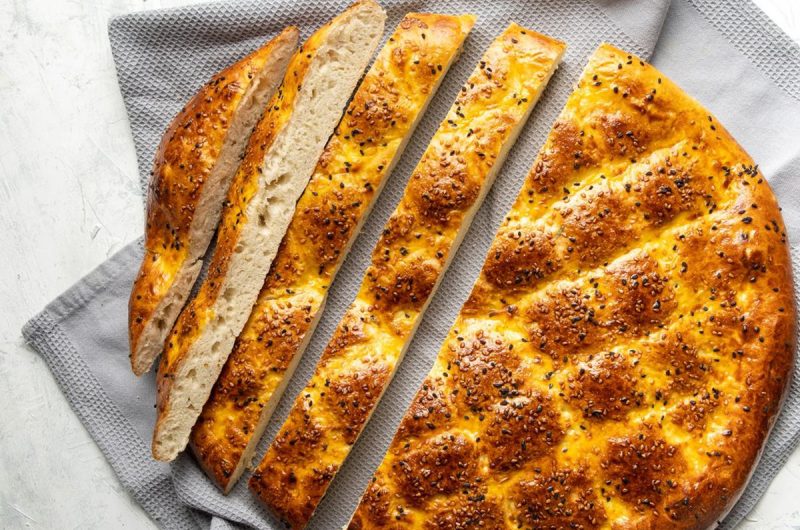© All Rights Reserved.
Fatir Bread Recipe | Delicious Persian Unleavened bread
Fateer Bread, or unleavened bread, is a bread that has not been made from yeast, or in the term, it has not been leavened. Fatir in the word means dough that does not rise.
The texture of the Fatir Bread has a special shape, and it has a stale state; the Fatir Bread dough is not ripe like other bread.
Fatir Bread, which is a tasty and nutritious snack itself, is made of flour, sugar, eggs, and other ingredients and is baked in the oven like bread. Fatir has different types, including Kasmeh and Shirmal.
Some sweets that are baked in different parts of the country are called fatir.
In some parts of Iran, a local bread or pastry called fatir is baked, and sometimes yeast is used to prepare it.
Fatir bread is from Azerbaijan that is prepared in different models, you can make the bread both plain and nutty.
Inside this delicious bread, there are ingredients similar to halva, a little drier than yellow halva, which you can put whatever you want.
You can even put ingredients like Qottab (walnuts, cinnamon, cardamom, and sugar) in the middle part of this bread. This type of local bread is cooked in different ways.
Ingredients for making Fatir Bread
Fateer main Ingredients
| White flour | About 2 cups |
| Sugar | 1 cup |
| Liquid oil | ⅓ a cup |
| Lukewarm milk | 1 cup |
| Salt | ½ a teaspoon |
Yeast ingredients
| Lukewarm water | ⅓ a cup |
| Sugar | 1 tablespoon |
| Yeast powder | 1 tablespoon |
For the top coat bread layer
| Milk | ⅓ a cup |
| Powdered sugar | 1 tablespoon |
| Egg yolk | 1 Piece |
| Vanilla | ½ a teaspoon |
Recipe for making Fatir Bread
The first stage
First, to make the yeast, we mix ⅓ a cup of lukewarm water with 1 tablespoon of sugar until the sugar dissolves in the water; then, we add the instant yeast powder, close the lid of the container, and leave for 10 minutes. Place in a warm place.
The second stage
We mix lukewarm milk with eggs, sugar, and liquid oil into a spacious bowl at this stage. Next, add the prepared yeast dough, add the flour little by little, and mix with a spoon.
The third stage
After the dough was gathered, we kneaded it by hand until it had very little stickiness.
Note that if you add too much flour, the dough will be hard and dry. After the dough is ready, grease a deep and spacious container.
The fourth stage

Then we grill the dough in a dish and, cover it with a towel, and place it in a warm place for about one to one hour and 30 minutes until the volume of the dough doubles. After the dough was ready, we kneaded it a little to make it airy.
The fifth stage
Now, we turn the dough into wedges bigger than walnuts, sprinkle flour on the work surface, and open the wedges with a rolling pin.
Next, we either grease the bottom of the oven tray with a little oil or cover it with parchment paper.
The sixth stage

After opening the parts of the dough with a rolling pin, we lift them by hand and place them in the oven tray.
After opening all the parts and placing them in the oven tray, cover them with a clean towel so they don’t dry out.
The seventh stage
We rest the dough in this state for about 30 minutes. After this time, we mixed the top coat ingredients together and wiped the dough with that.
We can also sprinkle a little sesame, Nigella sativa, or purslane seeds on the dough if desired.
The eighth stage
We turn on the oven 15 minutes before with a temperature of 180 degrees Celsius so that it is completely heated;

then we put the fatir bread in the oven for 15 to 20 minutes to cook. After cooking, we turn on the grill for a few minutes to color the dough.
Having a journey in the history of Fateer Bread
The origins of this bread are believed to be related to the Jewish people, and they have stated that when the Jews left Egypt, they did not have enough time to use leavened dough, so they had to cook unleavened bread with unleavened dough.
Unleavened bread is called Masa in Hebrew. Today, Jews only eat unleavened bread on Eid al-Fitr.
Fatir Bread has different types, which are prepared in different regions of Iran with different raw materials; sometimes, they use milk instead of water to prepare fatirs.
Among the most famous types of Fateer bread are Arak and Hamedan Fateer bread.
In our country, Iran, we all have a habit of preparing gifts and souvenirs for relatives after returning from a trip, and the best Fateer bread is from Arak province. In the past, the people of Arak usually gathered at one person’s house to cook Nowruz flour.
Today, with the passage of time, but with some changes, the baking of this bread continues in the central province and the city of Arak, and if you travel to this city, you will see various shops that are engaged in baking and selling fatir.
Fatirs are traditionally baked in the oven, and sometimes they can be prepared as nut bread or oiled bread with local butter.
Also, in different religions, such as Judaism and Christianity, a type of unleavened bread (Fatir bread) is cooked and used in different rituals and ceremonies.
Conclusion
Thank you for being with us with this delicious and popular souvenir. If you have any questions, it’s my honor to answer. Enjoy your exploration of Persian cuisine!
Please share this article with your friends on Facebook, Twitter, Pinterest, and other social media. 🧡
Fatir Bread Recipe
Course: Sweet, BreadCuisine: Persian FoodDifficulty: hard4
servings30
minutes40
minutes300
kcalThere is a type of Fatir bread, a sweet bread that is round or oval in shape, crispy and sweet, and made from flour, eggs, and sugar.
Ingredients
- Fateer main Ingredients
White flour, About 2 cups
Sugar, 1 cup
Liquid oil, ⅓ a cup
Lukewarm milk, 1 cup
Salt, ½ a teaspoon
- Yeast ingredients
Lukewarm water, ⅓ a cup
Sugar, 1 tablespoon
Yeast powder, 1 tablespoon
- For the top coat bread layer
Milk, ⅓ a cup
Powdered sugar, 1 tablespoon
Egg yolk, 1 Piece
Vanilla, ½ a teaspoon
Directions
- The first stage
First, to make the yeast, we mix ⅓ a cup of lukewarm water with 1 tablespoon of sugar until the sugar dissolves in the water; then, we add the instant yeast powder, close the lid of the container, and leave for 10 minutes. Place in a warm place. - The second stage
We mix lukewarm milk with eggs, sugar, and liquid oil into a spacious bowl at this stage. Next, add the prepared yeast dough, add the flour little by little, and mix with a spoon. - The third stage
After the dough was gathered, we kneaded it by hand until it had very little stickiness.
Note that if you add too much flour, the dough will be hard and dry. After the dough is ready, grease a deep and spacious container. - The fourth stage
Then we grill the dough in a dish and, cover it with a towel, and place it in a warm place for about one to one hour and 30 minutes until the volume of the dough doubles. After the dough was ready, we kneaded it a little to make it airy. - The fifth stage
Now, we turn the dough into wedges bigger than walnuts, sprinkle flour on the work surface, and open the wedges with a rolling pin.
Next, we either grease the bottom of the oven tray with a little oil or cover it with parchment paper. - The sixth stage
After opening the parts of the dough with a rolling pin, we lift them by hand and place them in the oven tray.
After opening all the parts and placing them in the oven tray, cover them with a clean towel so they don’t dry out. - The seventh stage
We rest the dough in this state for about 30 minutes. After this time, we mixed the top coat ingredients together and wiped the dough with that.
We can also sprinkle a little sesame, Nigella sativa, or purslane seeds on the dough if desired. - The eighth stage
We turn on the oven 15 minutes before with a temperature of 180 degrees Celsius so that it is completely heated;
then we put the fatir bread in the oven for 15 to 20 minutes to cook. After cooking, we turn on the grill for a few minutes to color the dough.


